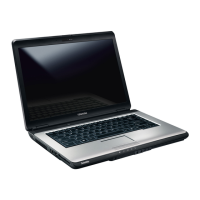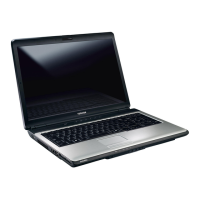Do you have a question about the Toshiba SATELLITE L310 and is the answer not in the manual?
States equipment compliance with FCC Part 15 rules.
Lists items to check after unpacking the computer.
Details the computer's processor, memory, and video capabilities.
Describes the computer's power sources like battery and AC adapter.
Describes various ports like HDMI, USB, and i.LINK.
Information on modem, LAN, and wireless LAN features.
Converts AC power to DC power and adjusts voltage for computer use.
Step-by-step instructions for installing the computer's battery.
Guides on connecting the AC adaptor for power and charging.
Guides through the initial setup process for Windows Vista.
Explains how to use the TouchPad for pointer control and scrolling.
Details enrolling and recognizing fingerprints for authentication.
Explains various hot key combinations for system functions.
Explains how power status affects computer capability and battery status.
Describes the meaning of the battery and power indicator lights.
Instructions for proper battery care to ensure safe operation and performance.
Explains how the battery indicator behaves during charging.
Tips on how to extend the battery's useful life and operating time.
Instructions for removing and installing a new battery pack.
Details the computer's power-up modes: Boot, Hibernation, and Sleep.
Allows setting or resetting the user password for power on.
Sets the priority for booting the computer from different drives.
Guidelines for resolving problems effectively and safely.
Simple solutions to check for common problems.
Questions to help identify the cause of system malfunctions.
Discusses problems related to computer hardware and peripherals.
Explains the automatic self-test run during computer startup.
Addresses problems related to the computer's power sources.
Troubleshooting steps for issues with AC power connection.
Troubleshooting steps for battery-related problems.
Addresses problems related to keyboard configuration and input.
Troubleshooting for issues with the hard disk drive.
Troubleshooting for issues accessing CD/DVDs in the drive.
Troubleshooting for issues accessing CD/DVD/HD DVDs in the drive.
Troubleshooting for issues accessing CD/DVD/HD DVDs in the drive.
Troubleshooting for USB mice and TouchPads.
Troubleshooting for USB mouse issues like unresponsive pointer or double-clicking.
Troubleshooting for USB devices not working.
Troubleshooting for issues with the USB Sleep and Charge feature.
Troubleshooting for computer hangs after memory module installation.
Troubleshooting for monitor issues like no power or display errors.
Troubleshooting communication software, dial tone, connection, and ring issues.
Troubleshooting LAN access issues.
Troubleshooting wireless LAN access.
Troubleshooting issues with fingerprint reading and enabling features.
States equipment compliance with FCC Part 15 rules.
Lists items to check after unpacking the computer.
Details the computer's processor, memory, and video capabilities.
Describes the computer's power sources like battery and AC adapter.
Describes various ports like HDMI, USB, and i.LINK.
Information on modem, LAN, and wireless LAN features.
Converts AC power to DC power and adjusts voltage for computer use.
Step-by-step instructions for installing the computer's battery.
Guides on connecting the AC adaptor for power and charging.
Guides through the initial setup process for Windows Vista.
Explains how to use the TouchPad for pointer control and scrolling.
Details enrolling and recognizing fingerprints for authentication.
Explains various hot key combinations for system functions.
Explains how power status affects computer capability and battery status.
Describes the meaning of the battery and power indicator lights.
Instructions for proper battery care to ensure safe operation and performance.
Explains how the battery indicator behaves during charging.
Tips on how to extend the battery's useful life and operating time.
Instructions for removing and installing a new battery pack.
Details the computer's power-up modes: Boot, Hibernation, and Sleep.
Allows setting or resetting the user password for power on.
Sets the priority for booting the computer from different drives.
Guidelines for resolving problems effectively and safely.
Simple solutions to check for common problems.
Questions to help identify the cause of system malfunctions.
Discusses problems related to computer hardware and peripherals.
Explains the automatic self-test run during computer startup.
Addresses problems related to the computer's power sources.
Troubleshooting steps for issues with AC power connection.
Troubleshooting steps for battery-related problems.
Addresses problems related to keyboard configuration and input.
Troubleshooting for issues with the hard disk drive.
Troubleshooting for issues accessing CD/DVDs in the drive.
Troubleshooting for issues accessing CD/DVD/HD DVDs in the drive.
Troubleshooting for issues accessing CD/DVD/HD DVDs in the drive.
Troubleshooting for USB mice and TouchPads.
Troubleshooting for USB mouse issues like unresponsive pointer or double-clicking.
Troubleshooting for USB devices not working.
Troubleshooting for issues with the USB Sleep and Charge feature.
Troubleshooting for computer hangs after memory module installation.
Troubleshooting for monitor issues like no power or display errors.
Troubleshooting communication software, dial tone, connection, and ring issues.
Troubleshooting LAN access issues.
Troubleshooting wireless LAN access.
Troubleshooting issues with fingerprint reading and enabling features.
| Graphics | Intel GMA X3100 |
|---|---|
| Battery | 6-cell Lithium-Ion |
| Display | 15.4" WXGA (1280x800) |
| RAM | Up to 4GB DDR2 |
| Storage | 160GB to 250GB HDD |
| Operating System | Windows Vista |
| Optical Drive | DVD SuperMulti drive |
| Wireless | 802.11b/g |
| Ports | 3 x USB 2.0, 1 x VGA, 1 x Headphone, 1 x Microphone |
| Processor | Intel Core 2 Duo |











